

How to Tell the Difference Between Real Education and Propaganda. The other day I ran across a passage from That Hideous Strength which seems oddly applicable to our time.
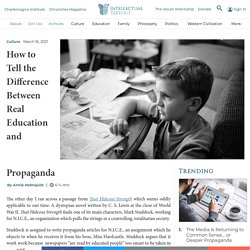
A dystopian novel written by C. S. Lewis at the close of World War II, That Hideous Strength finds one of its main characters, Mark Studdock, working for N.I.C.E., an organization which pulls the strings in a controlling, totalitarian society. Studdock is assigned to write propaganda articles for N.I.C.E., an assignment which he objects to when he receives it from his boss, Miss Hardcastle. How the Brain Works Best by Dr. Bruce Perry. What Do Emotions Have to Do with Learning? Thinkstock When parents and teachers consider how children learn, it’s usually the intellectual aspects of the activity they have in mind.

Sidney D’Mello would like to change that. The Neuroscience Behind Stress and Learning. The realities of standardized tests and increasingly structured, if not synchronized, curriculum continue to build classroom stress levels.

Neuroimaging research reveals the disturbances in the brain's learning circuits and neurotransmitters that accompany stressful learning environments. The neuroscientific research about learning has revealed the negative impact of stress and anxiety and the qualitative improvement of the brain circuitry involved in memory and executive function that accompanies positive motivation and engagement. The Proven Effects of Positive Motivation. Thinking Minds – Educate yourself. Effortless Learning. Press Release 11-257 Vision Scientists Demonstrate Innovative Learning Method New research suggests it may be possible to learn high-performance tasks with little or no conscious effort December 8, 2011 View a video showing researchers explaining Decoded Neurofeedback.
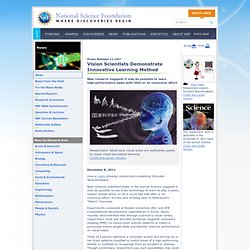
Education - Challenge Based Learning. Improving Long-term Learning Through Spacing Of Lessons. Combine the aphorisms that "practice makes perfect" and "timing is everything" into one and you might get something resembling findings published in this month's issue of Psychological Science.

Proper spacing of lessons, the researchers report, can dramatically enhance learning. And larger gaps between study sessions result in better recall of facts. People learn new information more effectively when brain activity is consistent, research shows. AUSTIN, Texas--People are more likely to remember specific information such as faces or words if the pattern of activity in their brain is similar each time they study that information, according to new research from a University of Texas at Austin psychologist and his colleagues.

The findings by Russell Poldrack, published online today in the journal Science, challenge psychologists' long-held belief that people retain information more effectively when they study it several times under different contexts and, thus, give their brains multiple cues to remember it. "This helps us begin to understand what makes for effective studying," says Poldrack, director of the Imaging Research Center (IRC) at The University of Texas at Austin. "Sometimes we study and remember things, sometimes we don't and this helps explain why. " Until now, scientists have used functional magnetic resonance imaging (fMRI) technology to examine activity in large regions of the brain when studying memory. Spacing effects in learning: A temporal ridgeline of optimal retention. Formula for success in learning. If you have found this place in the vast cyberspace of the web, you are probably not the one to convince that knowledge is power, and that solutions to most problems facing humanity could be found if we were armed with more understanding of how the world works.
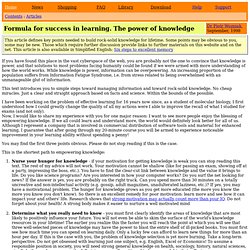
While knowledge is power, information can be overpowering. An increasing proportion of the population suffers from Information Fatigue Syndrome, i.e. from stress related to being overwhelmed with an unmanageable glut of information. This text introduces you to simple steps toward managing information and toward rock-solid knowledge. No cheap miracles. People learn better when brain activity is consistent. An intriguing new study has found that people are more likely to remember specific information if the pattern of activity in their brain is similar each time they study that information.
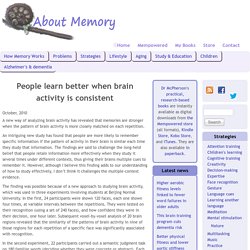
The findings are said to challenge the long-held belief that people retain information more effectively when they study it several times under different contexts, thus giving their brains multiple cues to remember it. However, although I believe this finding adds to our understanding of how to study effectively, I don’t think it challenges the multiple-context evidence. The finding was possible because of a new approach to studying brain activity, which was used in three experiments involving students at Beijing Normal University. Gesturing to improve memory, language & thought. I recently reported on a study showing how the gestures people made in describing how they solved a problem (the Tower of Hanoi) changed the way they remembered the game.
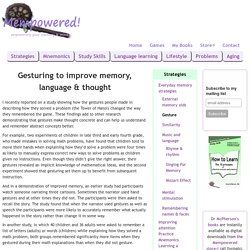
These findings add to other research demonstrating that gestures make thought concrete and can help us understand and remember abstract concepts better. For example, two experiments of children in late third and early fourth grade, who made mistakes in solving math problems, have found that children told to move their hands when explaining how they’d solve a problem were four times as likely to manually express correct new ways to solve problems as children given no instructions. Even though they didn’t give the right answer, their gestures revealed an implicit knowledge of mathematical ideas, and the second experiment showed that gesturing set them up to benefit from subsequent instruction. And in a demonstration of improved memory, an earlier study had participants watch someone narrating three cartoons. Variety is the key to learning.
On a number of occasions I have reported on studies showing that people with expertise in a specific area show larger gray matter volume in relevant areas of the brain.
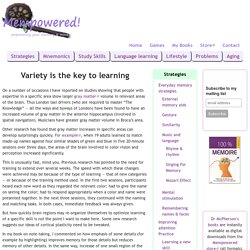
Thus London taxi drivers (who are required to master “The Knowledge” — all the ways and byways of London) have been found to have an increased volume of gray matter in the anterior hippocampus (involved in spatial navigation). Musicians have greater gray matter volume in Broca’s area. Other research has found that gray matter increases in specific areas can develop surprisingly quickly. For example, when 19 adults learned to match made-up names against four similar shades of green and blue in five 20-minute sessions over three days, the areas of the brain involved in color vision and perception increased significantly.
This is unusually fast, mind you. ContextuAll. Convey Interest. Memory. Super memo learning. Conscious Learning. Growth Mindset. Education & Learning. Artistic Endeavour. Comfiture. Language Informs. Memory. Skill Sets. Attendant. Brains. Interventionally. Artificially Intelligent.